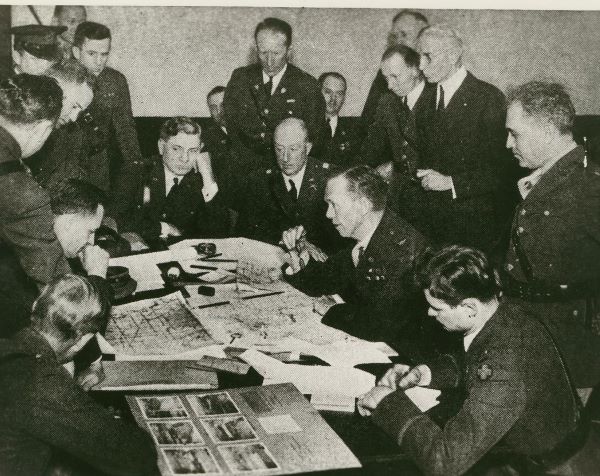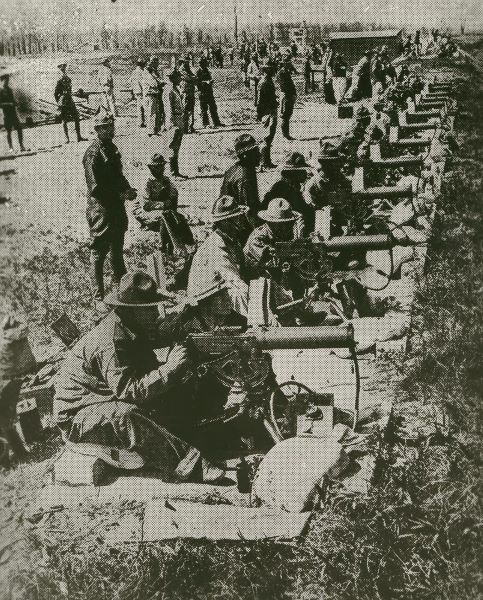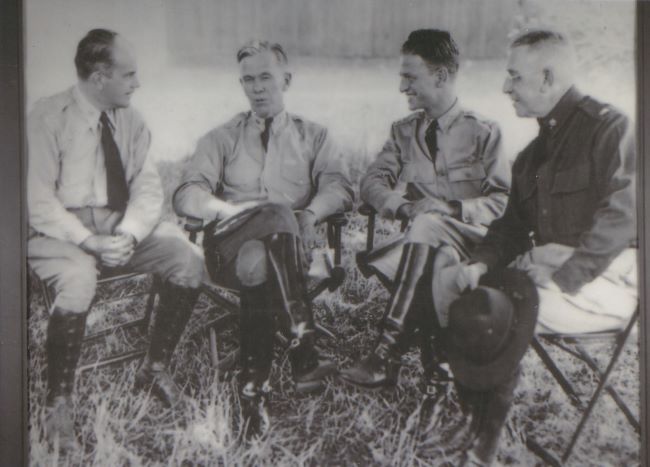Newly promoted Col. George Marshall had only been commanding officer at Fort Moultrie, SC, for a few months in an anticipated two-year tour when he received orders to report as the senior instructor to the Illinois National Guard, then the 33rd Division, commanded by Maj. Gen. Roy D. Keehn.
The orders surprised the Marshalls, as Katherine explained in her book, Together. Thinking that they would be in South Carolina for a long while, she had just taken delivery of furniture that had been stored in Baltimore since her marriage to Marshall a few years earlier, when the orders for Chicago unexpectedly arrived.
The team of Gen. Keehn and Col. Marshall turned out to be a great one for the Illinois National Guard, and changes came quickly. Unit staff officers realized that their weekly Monday meetings “had ceased to be the familiar, haphazard affairs of the past, that the entire staff had a goal in front of it, and each officer a definite job in which he was expected by Colonel Marshall to produce results.”
One of the first things Marshall did was set up an expectation of professionalism – the unit rented extra space at the guard headquarters on upper floors in the City National Bank and Trust Company building on LaSalle Street, now a Marriott hotel. Marshall had a desk and nameplate for each staff officer ready for their next Monday evening meeting.

City National Bank and Trust Company, where the Illinois National Guard had its headquarters.
He then put the officers to work during that winter, while they only had access to “pencils, paper, maps, and telephone,” a command post exercise. The officers worked their way through an “elaborate map maneuver” during their Monday night meetings.

Marshall working with his staff on a command post exercise the winter of 1935.
Gen. Keehn was very interested in this training, as the attorney had no military experience when he was appointed commander of the division by the governor of Illinois. However, he had learned enough through experience to know that “his division was not all it should be.”
Marshall supervised 35 officers and non-commissioned offers who were instructors with the unit. He expected strict discipline in the units. He wanted training “conducted in a smart military atmosphere, as business, not as fun.”

Marshall planning for field maneuver problems.
Marshall and Keehn appeared before the Illinois Legislature urging better support of their National Guard. Keehn sought funds from the federal government for armory construction during a trip to Washington, D.C. in April 1935. As president of the National Guard Association, Keehn went to Army Chief of Staff Gen. Douglas MacArthur to talk with him about building new armories. MacArthur declined to offer funding as he was trying to get an increase in funding for the Regular Army that year.

Maj. Gen. Roy Keehn, commanding officer of the 33rd Division.
Keehn asked if he could try to get funding on his own, and with MacArthur’s permission, went to President Roosevelt to ask for appropriations from the Public Works Commission.
President Roosevelt suggested they be called community centers to not rile the pacifism in the country, so the armories were built as community centers. The buildings were larger than the Guard needed to make space for community activities.

Richard L. Jones National Guard Armory, Chicago
Marshall continued working with the training of the divisions, and the units spent the summer of 1935 in annual training at Camp Grant in Rockford, IL. The units worked a three-day maneuver; it was “the first time the division had actually moved off the camp reservation for field exercises.”

Training at Camp Grant

Marshall with other senior officers at Camp Grant
Within two hours of finishing the exercise, Marshall had gathered the officers and gave them a four-hour critique. A written report of Marshall’s critique was provided to each soldier in the units; Marshall wanted “every man in the division to know what the purpose of the maneuvers had been, how the problem had been attacked and solved, what the shortcomings were — all the facts, and the reasons for them.”

Marshall’s critique
The next summer, the Second Army held annual training maneuvers in Michigan. Marshall was actually on the force opposing his own 33rd Division!

Preparing to oppose his own men at Second Army maneuvers
He commanded a brigade designed to outmaneuver his division, and had “the enormous satisfaction of seeing his training pay dividends in the highly competent staff work and operations of the Guardsmen.”

Marshall visiting with other senior officers at the end of Second Army training in Michigan.
Soon after, Marshall was promoted to brigadier general and transferred from Chicago, but he surely left a different unit than he had joined. The teaching and learning experiences at the 33rd Infantry would be invaluable when Marshall became Army Chief of Staff a few years later and needed to federalize thousands of National Guard soldiers in preparation for World War II.
Notes:
Quotes from Marshall, Citizen Soldier by William Frye.
Bank building photo from GlobeSt.com
National Guard Armory photo from wbez.org
Many thanks to Dave Cade, who connected me with the 33rd Infantry unit history, and without whom, this blog could not have been written.
